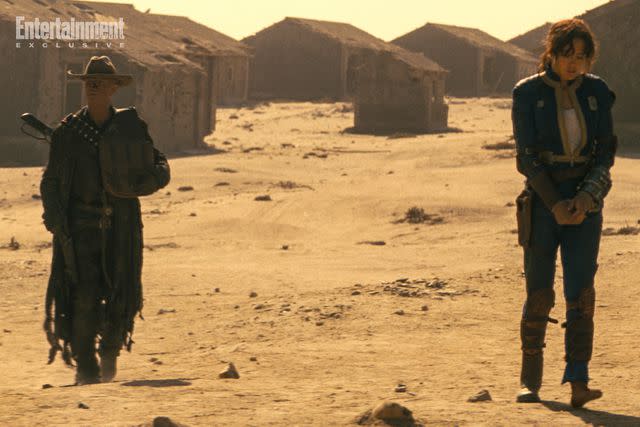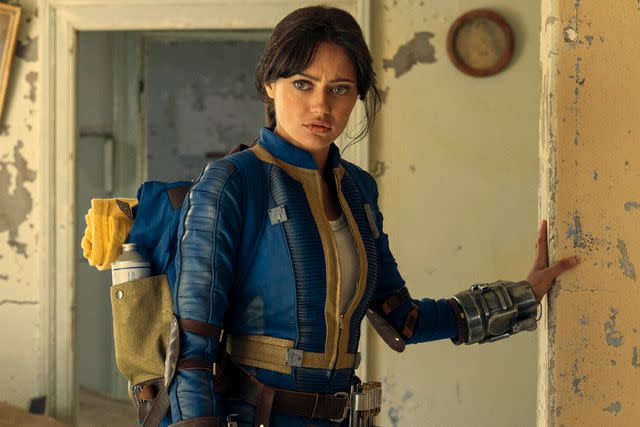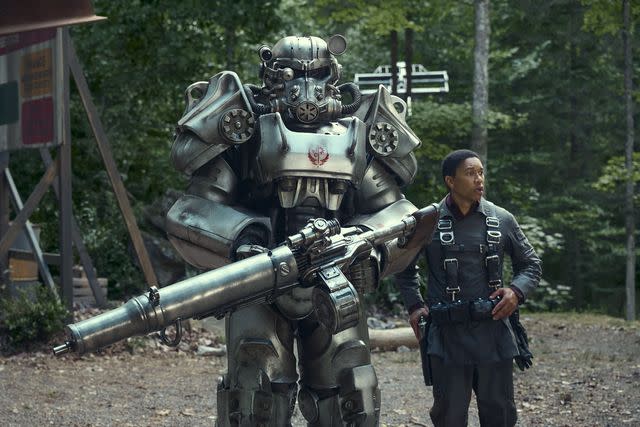How Amazon's “Fallout” brought the post-apocalyptic video games to TV
“I certainly didn't anticipate the tactile quality of this show," star Walton Goggins says. Read more about the franchise's long journey to the small screen.
The world of Fallout is closer than it appears. That’s always been true of the long-running series of post-apocalyptic video games, which mix images of Eisenhower-era Americana with futuristic power armor and radioactive monsters. But back in January 2023, it also described Amazon Studios’ new TV adaptation of the franchise. On those winter days, if you had walked just behind the walls of Steiner Studios at the Brooklyn Navy Yard, you would’ve been greeted with the sight of the ramshackle buildings of Filly, the rare outpost of civilization in the irradiated wasteland of Fallout.
Walk a little further, into the studio, and you would’ve found yourself in an eerie recreation of a Vault, the high-tech bomb shelters where some privileged humans of the Fallout world survive the apocalypse in relative comfort while others have to make the best of things out in the wasteland. Walking even further into the studio, you would’ve eventually found yourself in a room full of sand.
For Fallout character Lucy (Ella Purnell), this dirty run-down locale where nature has overgrown the remnants of human civilization is a far cry from the comfort of the Vault that she grew up in. But for viewers, this room (a replica of a real-life location in the Namibian ghost town of Kolmanskop) also represents a taste of the real world within this post-apocalyptic spectacle.
“I certainly didn't anticipate the tactile quality of this show,” Walton Goggins, who stars on Fallout as an irradiated gunslinger called The Ghoul, tells Entertainment Weekly a year after filming the scene. “When I read it for the first time, I was like, ‘Wow, this is really great, but how the f--- were we going to pull this off?’ But it became evident pretty early on that their intention was to film it in this very specific way, where they wanted to use practical locations and things in the world whenever possible.”

Courtesy of Prime Video
Jonathan Nolan, who directed the first three episodes of Fallout and created the show alongside his wife and creative partner Lisa Joy, had first considered using Kolmanskop as a locale for Westworld before deciding it didn’t look enough like the old West. But when it came time to start planning Fallout, Nolan’s mind immediately went to Kolmanskop.
“It doesn't feel Western. What it does feel like is a more contemporary, early 20th-century environment that's been left to its own devices,” Nolan explains on set. “It was a German mining town in the early 20th century. Then they started finding bigger diamonds down the coast, so they just pulled the roofs off and left. It’s house after house that looks exactly like this. It’s a long way to go, but it’s going the extra mile to find a place that really is post-apocalyptic.”
Nolan actually took the cast and crew down to Namibia’s Skeleton Coast to film much of the scene, but there wasn’t enough time on location to get all the footage they needed. So Nolan and production designer Howard Cummings worked to recreate the place in studio. And after lots of crew members ran back and forth with buckets of sand to get the look just right, they were able to finish.
The scene in question is universally referred to as “the ass jerky scene.” Mention that phrase to Nolan, Goggins, or Purnell and they know exactly what you’re talking about. After leaving her Vault in the series’ first episode, Lucy ends up in a strange partnership with the Ghoul. In this scene, they run into Roger (Neal Huff), another irradiated “ghoul” who has done a much worse job of maintaining his human side than Goggins’ character. On the precipice of finally descending into madness, Roger asks The Ghoul for help. He obliges, asking his old acquaintance to remember the joys of the pre-apocalypse world, like apple pie and ice cream.
With Roger distracted by reverie, The Ghoul shoots him in the head — and immediately begins carving meat off his body. When Lucy reacts in horror, The Ghoul humorously explains that her beloved father (Kyle MacLachlan) probably committed similar acts in order to survive.
In the span of just a few minutes, the scene is heartbreaking, horrifying, hilarious, surprising, and gross. In other words, it’s “like a diorama of this world,” Goggins says. “This is typical of a scene in Fallout, in that there is so much going on.”

JoJo Whilden/Prime Video
Ella Purnell in 'Fallout'Lucy’s resistance to cannibalism has a meta humor to it, since Purnell is coming to Fallout in the wake of her performance on Yellowjackets, a show that really explores what it takes to survive in a desolate situation. But as Purnell points out, the cannibalism doesn’t really start on Yellowjackets until after her character Jackie departs the story, meaning “this is the beginning of the Ella Purnell cannibalism narrative,” the actress says with a laugh. “It's the first time any of the characters that I've played have been introduced to cannibalism, and she’s rightly horrified.”
After working with other young actresses on Yellowjackets, Fallout put Purnell side-by-side with Goggins, who has steadily become the prolific MVP of the last decade of American TV. But if you thought his hair and makeup as Uncle Baby Billy on The Righteous Gemstones was transformative, The Ghoul’s extensive prosthetics (designed by Vincent Van Dyke) are on a whole other level.
“Watching Walton work is such a treat. He's such a dedicated, nuanced, funny performer and a very generous scene partner,” Purnell says. “I remember the first time I saw him on set, standing head-to-toe in prosthetics, plus the jacket and everything. It was like 96 degrees in New York, and I thought he was crying. Then I realized he wasn’t crying, he was sweating. He had a tough job and he was just such a trooper, such a professional.”
Goggins says of the prosthetics, “It was a challenge to talk, man. The other thing I was deeply insecure about was whether or not the audience was going to understand what was going on with me. But thank God that Vincent Van Dyke made it thin enough so that you picked up all the little nuances that someone has in their face when they're communicating an idea subconsciously. So I would ask him after every take, ‘Are you seeing this? Is this just a blank canvas?’ And he said, 'Buddy, we see everything. It's all in your eyes, we understand everything that you're doing.’ Once I felt secure about that, then we were off to the races.”

Courtesy of Prime Video
Power Armor and Maximus (Aaron Moten) in 'Fallout.'Lucy and The Ghoul are two of Fallout’s core trinity of characters. The third is Maximus (Aaron Moten), a member of the Brotherhood of Steel. Together, these characters represent the different choices available to players of the Fallout games. Nolan credits that idea to Fallout showrunners Geneva Robertson-Dworet and Graham Wagner.
“One of the hallmark elements of the franchise is that you have to make decisions about whether your character's going to be good or bad. So how do we translate that moral ambiguity?” Nolan says. “So when Geneva and Graham came back and said, ‘We think it should be The Good, the Bad, and the Ugly, with three characters who each represent stations along that moral spectrum,’ that was a brilliant solution.”
As a member of the Brotherhood of Steel, Moten gets to wear the Power Armor that is such a signature element of the Fallout games. But Maximus is not exactly as chivalrous as the Brotherhood’s ideals would suggest.
“I got really, really drawn to this character. He reminded me of Cassius in Shakespeare’s Julius Caesar, a hungry dog,” Moten tells EW. “He's lived his whole life in the wasteland, it’s where he's born and raised, which is different from the other two main characters. That's a world and a mindset that we don't really know, and that really excited me.”
The Brotherhood of Steel seeks to bring order to the wasteland, and their operatives are divided between “knights” (who wear and wield the destructive Power Armor) and “squires” (who assist with cleaning and maintaining the suit). That kind of hierarchy is present throughout Fallout: The differences between the Vault-Dwellers and Wastelanders, and even between capable ghouls like Goggins and desperate ones like Roger. As it happens, Nolan was developing the show with Robertson-Dworet and Wagner while the COVID-19 pandemic was happening.
“That idea of two Americas, a group of people who get to sit out the apocalypse and a group of people who don't, unfortunately became very relevant,” Nolan says. “But the games have always been political and satirical. Graham was joking that the first game could have been written by Adbusters. But I'll tell you, it was expiation to go through this global nightmare working on something that was dealing with similar subject matter, but with a sense of humor. Being able to ask difficult questions with a little bit of comedy was definitely a relief for us when we were all going through some pretty dark days.”
Here we are a few years later, and viewers will get to enjoy Fallout without worrying as much about the dangers of going outside. Or perhaps the apocalypse is always closer than it appears.
Fallout is available on Prime Video now.
Sign up for Entertainment Weekly's free daily newsletter to get breaking TV news, exclusive first looks, recaps, reviews, interviews with your favorite stars, and more.
Related content:
Read the original article on Entertainment Weekly.


